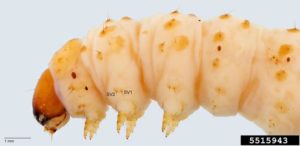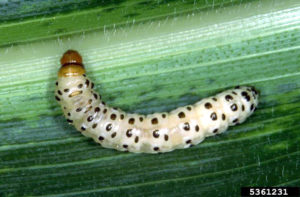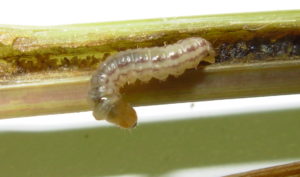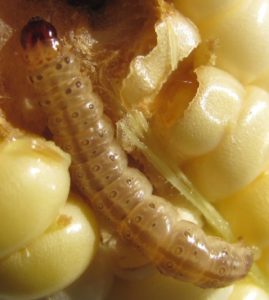According to the responses you entered, this is likely the type of pest you are dealing with. To confirm this, use the positive identification section. There are multiple species of caterpillars that commonly bore in sorghum stalks as shown below. They are all treated relatively the same in terms of management and their biology is quite similar unless otherwise noted below.

Mexican Rice Borer. Photo courtesy of LSU AgCenter and Dr. J. Saichuck(retired).
Biology
Lesser Cornstalk Borer
The lesser cornstalk borer feeds on roots and stems in silken tunnels which are covered with soil particles.
Other Common Sorghum Borers
Though the biology of each species listed may have some variations, they are all similar. Moths lay eggs on plants in an overlapping fish scale type arrangement. Within a week of being laid the caterpillars emerge. The young larvae feed on leaves and then tunnel into sorghum stalks. Caterpillars live about 25 days. On the inside borers will move up and down the stalk to feed.
Positive Identification

Lesser Cornstalk Borer (Elasmopalpus lignosellus). Photo by Richard Sprenkel.

Neotropical borer (Diatraea lineolata). Photo by Todd Gilligan.

Southwestern corn borer (Diatraea grandiosella). Photo by Frank Peairs.

Sugarcane Borer (Diatraea saccharalis). Photo by John Capinera, University of Florida.

Mexican Rice Borer (Eoreuma loftini). Photo courtesy of the LSU AgCenter and Dr. J. Saichuk (retired).

European corn borer (Ostrina nubilalis). Photo by Sara Simpkins.
Positive identification information
Lesser Cornstalk Borer
Lesser cornstalk borers are light bluish green with prominent reddish-brown bands.
Other Common Sorghum Borers
These caterpillars are creamy white in color. They can get as long as 1 inch. Their body segments have obvious round black or brown spots on them.
Scouting Tips
Examine sorghum plants looking for small holes near the leaf axis. These are entry holes where the caterpillars enter the stalk. Once larvae have entered a stalk must be split to find the actual larvae.
Although we tried to include the most significant pests related to sorghum our tool cannot help you identify every insect found on sorghum. This tool is built to inform you of the most common and significant pests of sorghum in Texas. If the insect you are dealing with does not match the description above then talk to your extension agent or visit this page to look at all the different important potential pest associated with each part and growth stage of sorghum.
Other Image Details:
Lesser Cornstalk Borer photo by Richard Sprenkel. Richard Sprenkel, University of Florida, Bugwood.org
 licensed under a Creative Commons Attribution-Noncommercial 3.0 License.
licensed under a Creative Commons Attribution-Noncommercial 3.0 License.
Neotropical borer (Diatraea lineolata). Photo by Todd Gilligan. LepIntercept, USDA APHIS ITP, Bugwood.org
 licensed under a Creative Commons Attribution-Noncommercial 3.0 License.
licensed under a Creative Commons Attribution-Noncommercial 3.0 License.
Southwestern corn borer (Diatraea grandiosella). Photo by Frank Peairs. Colorado State University, Bugwood.org
 licensed under a Creative Commons Attribution 3.0 License.
licensed under a Creative Commons Attribution 3.0 License.